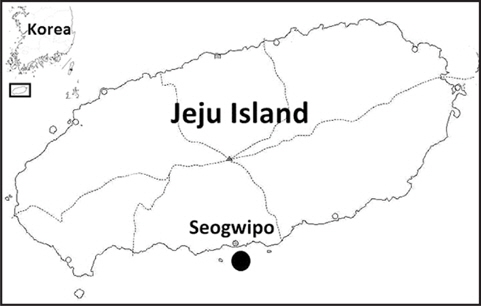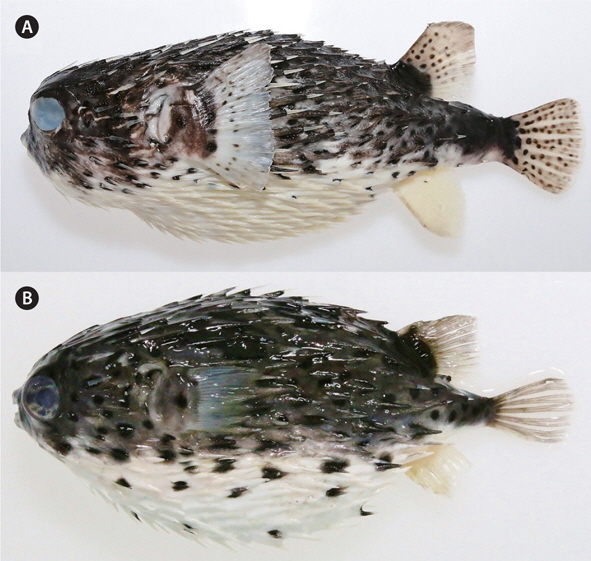



The family Diodontidae belonging to the order Tetraodontiformes, comprises 19 species in six genera worldwide (Nelson, 2006). Seven species in three genera are known from Japan (Aizawa and Doiuchi, 2013), but only two species in two genera
A single specimen in the family Diodontidae was caught by seine net south of Seo-gwi-po fishing port, Jeju Island, in July 2013 (Fig. 1). Morphological counts were made and measurements were taken using Vernier calipers and recorded to the nearest 0.1 mm, according to the methods of Hubbs and Lagler (2004). Identification followed Leis (1978, 1991) and Aizawa and Doiuchi (2013). The specimen was registered and preserved at Pukyong National University (PKU), Korea.
Comparative materials examined.
>
Diodon hystrix Linnaeus, 1758 (
[Table 1.] Comparison of meristic characters for Diodon hystrix among authors

Comparison of meristic characters for Diodon hystrix among authors
D. 14; A. 14; P. 21. Meristic characters are shown in Table 1.
Measurements as percentage of standard length (SL): head length 41.7; dorsal fin length 19.8; pectoral fin length 16.8; anal fin length 20.1; pre-dorsal fin length 77.2; pre-pectoral fin length 43.9; pre-anal fin length 78.3; pre-anus length 75.1; body depth 37.3; body width 42.4; caudal peduncle length 20.0; caudal peduncle depth 9.6. Measurements as percentage of head length (HL): eye diameter 18.8; snout length 41.2
Body relatively short, moderately oval, inflatable. Body and head covered with long, sharp, moving spines; most body 382spines 2-rooted and erectile; length of spines on forehead 1-1.5 times the eye diameter, longer than spines on dorsal and ventral areas of body. Lateral line inconspicuous. Eye very large and round. Snout short, interorbital width long. Mouth small, upper jaw longer than lower jaw. Upper and lower jaw teeth united in each jaw without a median suture. Posterior tip of lips not reaching to anterior margin of eye. Nasal organ located in front of eye; a short tube with two openings. Gill opening very small, a vertical slit immediately before pectoral fin base. Dorsal and anal fins in posterior region of body, symmetric, lacking fin spines, vertical, slightly rounded. Pectoral fins truncate, not reaching anterior base of dorsal fin. Pelvic fins absent; caudal fin slightly rounded. Dorsal and ventral surfaces of caudal peduncle with one and two small spines, respectively (Fig. 3).
Body and head dark brown dorsally, but white ventrally; body with many black or dark brown spots dorso-laterally, diameter smaller than that of eye; all fins except anal fin with many small black spots.
This species is distributed off Jeju Island, Korea (present study), and also in tropical to temperate waters of the Pacific, Atlantic, and Indian Oceans. The species is found near reef areas in water depths of 2-100 m (Leis, 1991; Froese and Pauly, 2014).
The family Diodontidae is similar to the family Tetraodontidae, but differs in having sharp spines on the surface of the head and body but not the fins, and strong teeth fused into a single beak-like plate in each jaw without a median suture (Leis, 1991; Nelson, 2006). Diodontidae contains six genera, of which the genus



